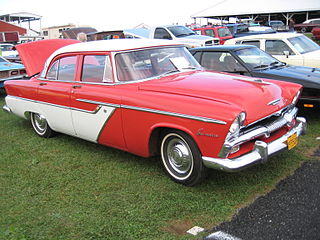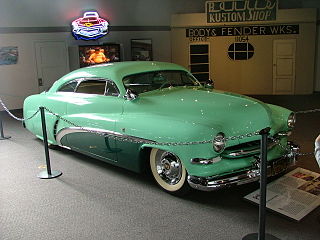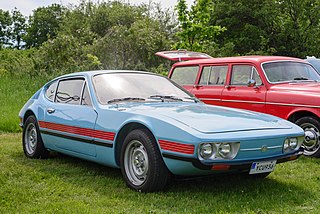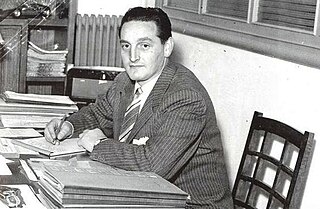
Volkswagen is a German automobile manufacturer headquartered in Wolfsburg, Lower Saxony, Germany. Founded in 1937 by the German Labour Front under the Nazi Party and revived into the global brand it is known as today post-World War II by the British Army officer Ivan Hirst, it is known for the iconic Beetle and serves as the flagship brand of the Volkswagen Group, the largest automotive manufacturer by worldwide sales in 2016 and 2017. The group's biggest market is China, which delivers 40 percent of its sales and profits. Its name is derived from the German-language terms Volk and Wagen, translating to "people's car" when combined.

The Porsche 914 or VW-Porsche 914 is a mid-engined sports car designed, manufactured and marketed collaboratively by Volkswagen and Porsche from 1969 until 1976. It was only available as a targa-topped two-seat roadster powered by either a flat-4 or flat-six engine.

The Volkswagen Karmann Ghia are a family of three overlapping sporty Volkswagen model series, marketed in 2+2 coupe (1955–1975) and 2+2 convertible (1957–1975) body styles, though German production ended one year before that in Brazil. Internally designated the Type 14 (1955–1975), the Type 34 (1962–1969), and the Type 145 TC, the Karmann Ghia cars combined the floorpans and mechanicals of the Type 1 / Beetle or Type 3 'ponton' models with styling by Italy's Carrozzeria Ghia, and hand-built bodywork by German coachbuilding house Karmann.
Wilhelm Karmann GmbH, commonly known as Karmann, was a German automobile manufacturer and contract manufacturer based in Osnabrück, Germany. Founded by Wilhelm Karmann in 1901, the company specialised in various automotive roles, including design, production and assembly of components for a wide variety of automobile manufacturers, including Chrysler, Porsche, Mercedes-Benz and Volkswagen Group.

Virgil Max "Ex" Exner Sr. was an automobile designer for several American automobile companies, most notably Chrysler and Studebaker.

The Volkswagen Type 3 is a compact car manufactured and marketed by Volkswagen from 1961 to 1973. Introduced at the 1961 Frankfurt International Motor Show, the IAA, the Type 3 was marketed as the Volkswagen 1500 and later as the Volkswagen 1600, in two-door notchback, fastback, and station wagon body styles, the latter marketed as the 'Squareback' in the United States.

In automotive design, an RR, or rear-engine, rear-wheel-drive layout places both the engine and drive wheels at the rear of the vehicle. In contrast to the RMR layout, the center of mass of the engine is between the rear axle and the rear bumper. Although very common in transit buses and coaches due to the elimination of the drive shaft with low-floor buses, this layout has become increasingly rare in passenger cars.

The Volkswagen Type 181 is a two-wheel drive, four-door, convertible, manufactured and marketed by Volkswagen from 1968 until 1983. Originally developed for the West German Army, the Type 181 also entered the civilian market as the Kurierwagen in West Germany, the Trekker in the United Kingdom, the Thing in the United States (1973–74), the Safari in Mexico and South America, and Pescaccia in Italy. Civilian sales ended after model year 1980.

A custom car is a passenger vehicle that has been altered to improve its performance, change its aesthetics, or combine both. Some automotive enthusiasts in the United States want to push "styling and performance a step beyond the showroom floor - to truly craft an automobile of one's own." A custom car in British usage, according to Collins English Dictionary, is built to the buyer's own specifications.

The Volkswagen Brasília is a rear-engined compact car developed by Volkswagen do Brasil and internally designated as the Type 321. Named for Brazil's capital city, the car was manufactured and marketed by Volkswagen in Brazil from 1973 to 1982; in Mexico from 1975 to 1982; and built from knock down kits in Nigeria, where it was marketed as the Igala from 1976 to 1980.
Volksrods are a style of modified Volkswagen Beetles that emulate the look of American hot rods. They are used as an alternative to traditional Ford-based hot rods, often by people who struggle to find affordable examples of classic Ford Model Ts and Model As.

The Volkswagen SP2 is a sports car that was developed by Volkswagen do Brasil and built from July 1972 until December 1975. It is based on the chassis of the Brazilian market Volkswagen Type 3. "SP" is said to be an initialism of São Paulo, where the car was built, or of "sports prototype". In its issue of 20 June 1973, German technology magazine Hobby called the SP2 the "most beautiful Volkswagen in the world".

Luigi "Gigi" Segre was an Italian automotive designer noted for his business and engineering acumen during his stewardship and ownership of Carrozzeria Ghia (1953–63), one of an Italy's premier automobile design and coachbuilders.

In automobile design, a rear-engine design layout places the engine at the rear of the vehicle. The center of gravity of the engine itself is behind the rear axle. This is not to be confused with the center of gravity of the whole vehicle, as an imbalance of such proportions would make it impossible to keep the front wheels on the ground.

The Volkswagen Golf Mk1 is the first generation of a small family car manufactured and marketed by Volkswagen. It was noteworthy for signalling Volkswagen's shift of its major car lines from rear-wheel drive and rear-mounted air-cooled engines to front-wheel drive with front-mounted, water-cooled engines that were often transversely-mounted.

The Volkswagen Beetle was introduced to Mexico in March 1954, inside the exhibition "Alemania y su Industria". Four different Volkswagen vehicles were brought to Mexico through Veracruz City for the first time. Those vehicles were: two Sedans 113 in "Export" trim, a convertible, and a VW Bus in luxury trim. Officially, the Bug/Beetle was named "Type I sedan" and the Bus was named "Type II station wagon", though variants included single and double cab pickups.
Sergio Sartorelli was a noted Italian automotive designer and engineer.

A Cal-Style VW is a lowrider influenced vintage Volkswagen, that for style and cruising was lowered to the extreme in the manner called "dumped" "slammed" or "laid out". The Cal-Style VW originated in the streets of Los Angeles in the late 1970s, when the first generation of teens from Latino neighborhoods veered away from the Low Riders that at the time were associated with gangs and criminal activity, and instead customized their economical VWs into lowriders for the cruising and teen subculture.

Karosserie Friedrich Rometsch, a German metallurgical-coachbuilding company based in Berlin-Halensee, manufactured, modified, and repaired coaches, trailers, bodies and chassis.

Wilhelm Karmann Jr. was a German entrepreneur. He took over the management of Wilhelm Karmann GmbH based in Osnabrück in 1952 and led the company to become a recognized partner of the automotive industry as a contract manufacturer of complete vehicles and as a supplier of pressed parts, production systems and roof modules for convertibles. He was also involved in numerous vehicle developments.

















